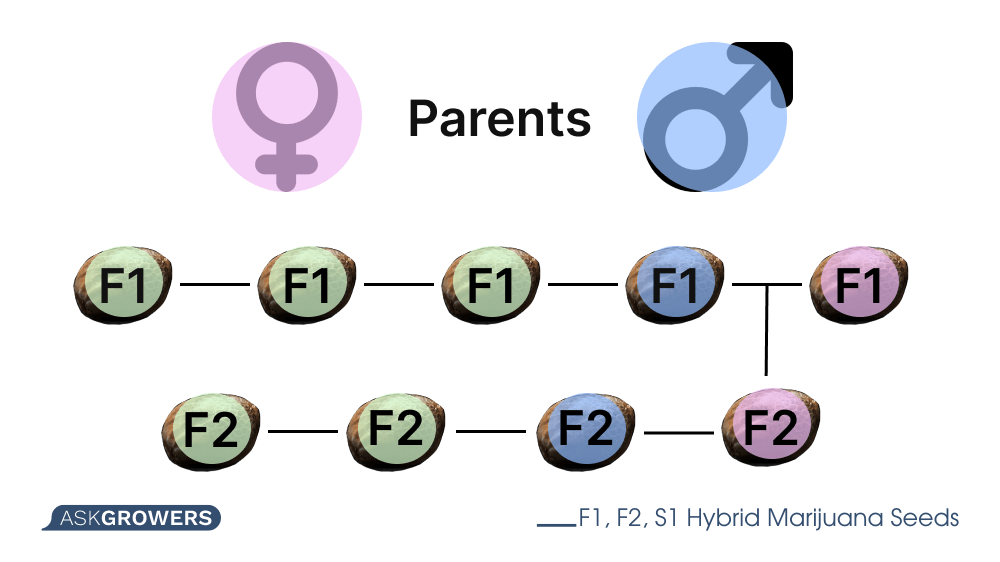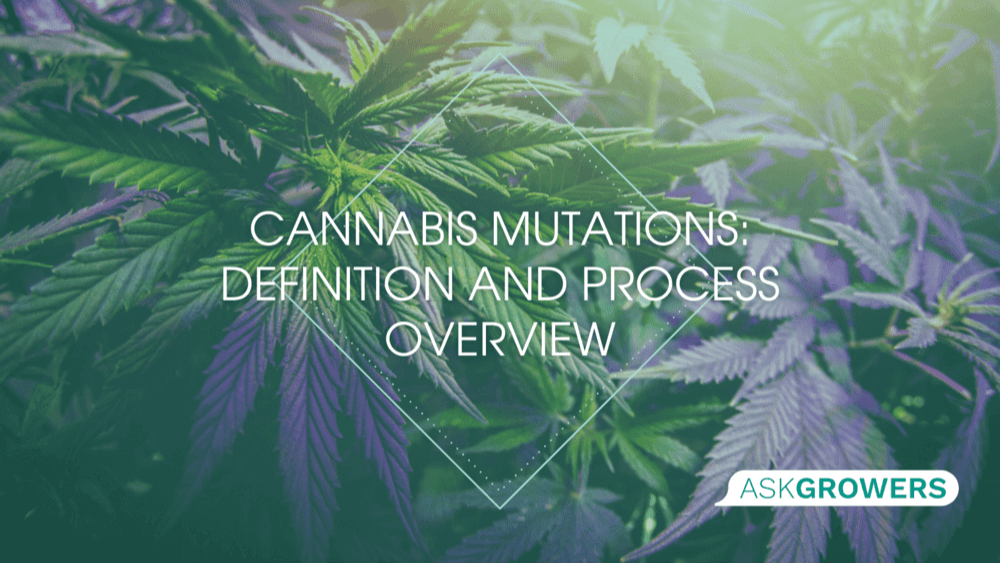F1, F2, S1 Hybrid Marijuana Seeds: Guide for Beginners
.png)
The cannabis market is growing rapidly, so it isn't surprising that more strains and hybrids are arriving. Most home growers tend to worry too much about breeding and pollination. The breeding cannabis seeds process for almost all strains can be as simple as you want or very complex, depending on your knowledge, skills, and preferences.
The biggest confusion in the weed industry is F1, F2, and S1 hybrids and their differences. Before we move to the definitions, let’s learn the basics of cannabis genetics seeds. Cannabis is dioecious; the species can be either female or male, in contrast to monecious, where one plant can have both male and female flowers.
Cannabis seeds are created when pollen from the male strain pollinates a female one. A hybrid cannabis is a result of cross-pollinating two different types of weed and growing the resulting seed that produces a completely new strain of marijuana. The plant that grows from the seed is called a hybrid strain. Cannabis can be pure (Indica or Sativa) or as a hybrid mix of strains (usually combining Indica and Sativa).
Hybrid cannabis is created to get customized plants with specific terpenes, effects, cannabinoids, THC levels, and purposes. Thanks to the popularity of cannabis history, more hybrids are arriving on the market, including F1, F2, and S1.

Read Also: Stages of Cannabis Ripening: How to Get a Spectacular Harvest
What Are F1 Seeds?
F1 hybrid is also known as Filial 1, or in layman’s terms, a “first child” plant. Simply put, they are the first generation of offspring developed from their parent strains. Breeders create this hybrid by crossing the strongest specimens in their collections. F1 is known as a strong and stable hybrid.
F1 hybrid weed seeds have the dominant genes from both parents. They also contain some of the same qualities (like effects, terpenes, and cannabinoids) as their parent plants that deliver their unique combination. Cultivators use special methods and breeding programs to get exactly the hybrid they want based on commercial needs.
F1 hybrids tend to be more resistant to diseases and have bigger strength and survival rates than specimens of a single genetic line. They can be identified by visible features they took from their parents and phenotype. As a result, growers can get a fluffy weed with long and isolated branches—a weed that has a pungent or subtle aroma.
The breeding process of F1 hybrids starts with identifying what breeders want to develop. They have to find what cannabinoids, terpenes, and effects they want to see in the final plant.
For instance, the breeder looking for the final plant with maximum THC and terpenes concentration will choose parents with the same features for the F1 genetics. Other breeders may want the strain of a small and compact but productive F1 hybrid suitable for indoor growing. The process of breeding F1 usually looks like this:
1. Parent Selection
After identifying the end goal, cultivators seek out parent strains that display the traits they are looking for the most. Choosing parents with high THC will help breeders achieve the final plant with the same or higher THC level. This rule applies to any trait breeders are looking for: size, resistance to diseases, color, and terpenes.
2. Developing Inbred Lines (IBLs)
F1 creation requires two strains. Crossing two specimens from two different IBLs will result in a uniform generation of F1 hybrids that has traits from both. Breeders have to cross two genetically different IBLs to reverse inbreeding depression in the final plants. Cultivators develop two different IBLs and try to develop separate traits in each.
Among the best daytime strains for products that have been grown from F1 seeds are the following: Medusa F1, Hyperion F1, Milky way F1, Apollo F1.
Read Also: How to Plant Marijuana Seeds: Secrets and Recommendations
What Are F2 Weed Seeds
In contrast to F1, F2 means second-generation hybrid. F2 cannabis seeds can be produced by hand pollination or open/self-pollination. These seeds are bred from the F1 hybrids. The breeding process of F2 hybrids differs from F1 seeds. This process is called “recombination.” It allows breeders to get the strain that remixes all the traits present that were passed on from the first generation.
F2 seeds are like the second degree of branching in a family tree. They tend to lose some of the traits and vigours that characterize F1 seeds. In addition, F2 hybrids can inherit only 50% of the properties of the mother or father plant. The remaining 50% of F2’s genetics make up intermediate characteristics. In contrast to F2 genetics, F1 hybrids resemble the parent strains like drops of water.
The key difference in breeding F1 vs F2 cannabis seeds is that in the second option, you are not creating a completely new cultivar. Breeders just recombine existing traits in new and novel ways. F2 generation seeds are not the best choice for most cultivators. F1 hybrids are more stable since F2 generation strains tend to be very inconsistent due to recombination. You can buy F1 marijuana seeds here, so you will be able to try to create your own hybrid.

What Is S1 Hybrid?
S1 is another type of cannabis seed. The “S” in its name stands for “self” or “selfed,” which means that the seeds will be selfed-generation. They do not require male plants for pollination. Instead, the female plant is reversed, allowing it to collect the pollen.
This pollen is then used to pollinate the mother strain or a clone of the mother to breed S1 hybrids. Males can also be selfed, but the process is extremely tricky and requires knowledge and focus, even in the case of the most experienced cultivators. If you are a beginner, it is best to start with autoflower seeds for sale here.
In order to develop S1 seeds, breeders need to take a cutting from a female mother plant and then transform it into a male plant, which can happen when the plant is under significant stress, like the application of silver thiosulphate. This allows the S1 genetics to go through reversion within a few weeks. Once done, the pollen produced by the clone plant is used to pollinate the original plant.
Another popular question among new cultivators looking for S1 hybrids is, how fast does weed grow? That is because some confuse S1 hybrids with autoflower seeds, which tend to have short flowering cycles. S1 seeds require 9 to 11 weeks to be ready for harvest.
Read Also: How to Sex a Marijuana Plant: Guide for Beginning Growers
What Are Other Types of Hybrid Weed Seeds?
IBL means inbred line. IBL seeds are bred by crossing plants with almost identical genotypes (inbreeding). Once strains are selected, those plants are interbred with each other, while the process repeats over and over until breeders reinforce the needed trait.
Another type of seed you can find in the market is polyhybrid cannabis seeds. Polyhybrids are specific cannabis varieties resulting from the crossing of two F1 hybrids. They tend to have bigger genetic variation than F1 hybrids since they are made from four IBLs. These varieties are used when hybrid seed production is low in the genetics lines.
F3 weed seeds refer to third-generation seeds. They are developed by either self/open pollination or hand pollination of F2 plants. These seeds are pretty rare, yet they can be found in online seed banks.

 Growing
Growing
 Guides
Guides







 (1).png)

.jpg)





Be the first and share your opinion
Write a Review